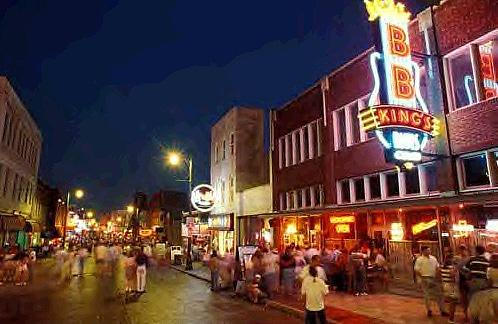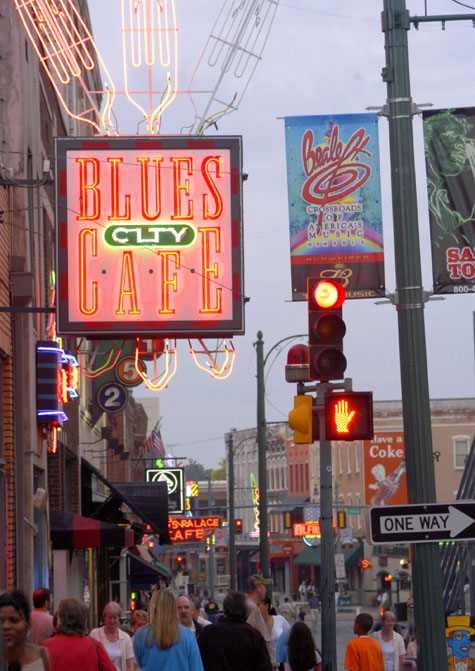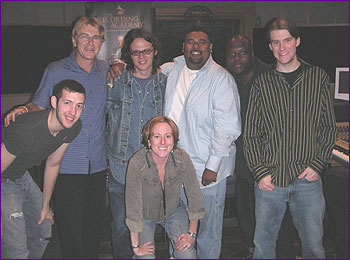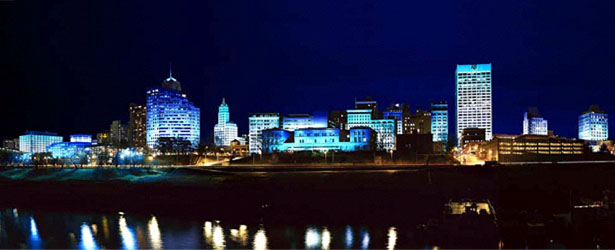Back to Goin' Down South

Electric Blue Watermelon session at Ardent
City History | Memphis Music | Beale Street | Studios and Labels
City History
The quick, non-romantic version of the history of Memphis goes like this: Memphis first belonged to the Chickasaw nation. In 1541 DeSoto claimed the area for Spain. Around the 17th century, de LaSalle claimed the entire Mississippi Valley for France. France and Spain kept claiming it for each other building their little forts until the United States joined in with their Fort Adams, a place for the poor Chickasaw nation to finally rest. However, in 1818, the Chickasaw just decided to relinquish West Tennessee to the US...I would have too....
Now getting a little more romantic: The following year, the City of Memphis was founded by three guys from Nashville: John Overton, James Winchester, and future President of the United States Andrew Jackson. The men named their new city for the capital of ancient Egypt with the mighty Mississippi as their Nile. Memphis was a well-deserved title for a city housing and birthing America’s pharaohs, a.k.a. gods on earth, a.k.a. the bluesmen and rockers of the South!

In 1897, Memphis' pyramid-shaped pavilion was a conspicuous part of the Tennessee Centennial exposition.
Now a little typical American history: Several decades after the city’s birth, Memphis finally became of hub of trade with the ports on the river and the Memphis & Charleston railroad. The front street along the riverbank was your typical western saloon town and became the bustling trading center for white gold, a.k.a. cotton.
The Civil War made its way to Memphis and Memphibians as they like to be called remained faithful followers of the Confederate cause. However, the city did not destroy itself like Atlanta or Vicksburg, and its economy never weakened.
A little statistical history: The Civil War launched social changes that would shape Memphis for decades. For example, Union authorities established a freedmen’s camp for escaping slaves just south of Memphis, which had to this point been settled primarily by whites. The population of the freedmen’s camp grew as the war went on, and most of the freedmen decided to stay after the war ended in 1865. Many moved into the southern part of the city around Beale Street, and the city’s black population grew from 4,000 to 15,000. The city’s population also ballooned to 55,000, making Memphis the sixth-largest city in the country. In addition to African Americans, a large Irish population made up part of early Memphis. In 1866, the death of an Irish boy fueled race riots between African American and Irish Memphibians when African American Union troops stopped the mainly Irish police from arresting an African American boy who was a suspect in the death. Many African Americans fled as Irish immigrants burned, looted, and murdered Beale Street residents in retaliation.
Now for some brutal history: Yellow fever and cholera epidemics killed more than 5,000 people in one month alone and caused another 25,000 (nearly half the population) to leave the city in the 1870s. By the end of the decade, Memphis was bankrupt and nearly vacant. As a result, the State of Tennessee revoked Memphis’ charter in 1879! It was the African Americans, having a much greater immunity to yellow fever, who assisted the sick, tended to the dead, and helped to rebuild the city after the disease had passed. A revival of river trade soon occurred in the 1880s, and the city began to recover.
Visit www.downtownmemphis.com and www.memphismojo.com for great city info.
Memphis Music
Well after the end of the Civil War, and the city’s reinstatement in 1893, African-Americans continued to be drawn to Memphis. Beale Street and the surrounding area became an economically thriving and vibrant black community. The city was soon to see a revolution in music that resulted in the first uniquely American music style, the Blues, the fore-runner of Soul and Rock & Roll, two more uniquely American music styles later born in Memphis.

Beale Street: Beale Street is one of the most famous streets in Memphis, and it is the soul of old Memphis. Beale Street would, of course, become home to the Blues. W.C. Handy established this new type of music out of Beale Street’s raucous, free-spirited environment. In the 20th century, Beale was a bustling street, and music could be heard in the night clubs and in the churches. Night life was sometimes a dangerous mix of seedy characters, easy money and liquor, and the evolutions of jazz was happening. This was the atmosphere that gave birth to the Blues. Other great Blues men following Handy were Muddy Waters, Furry Lewis, Albert King, Alberta Hunter, Bobby "Blue" Bland, Memphis Minnie McCoy, and in the 1940's Riley "Blues Boy" King, whose stage name would come to be known as B.B. King. Of course the 30s depression took its toll on the city, but Beale Street retained its vibrancy through World War II, and Memphis’ reputation for vice grew. As more and more affluent whites began migrating toward the suburbs, reform-minded city leaders began a major cleanup (a.k.a. Urban Renewal) of Beale Street, closing most of the saloons, pawnshops, and pool halls. As a result, the Memphis music scene lost much of its vitality. Beale Street was placed on the National Register of Historic Places in the 60s. Renovations and community and government investment in the Beale Street area made way for a celebrated entertainment district. The Blues can still be heard on Beale Street as well as Reggae, Rock, Fusion Jazz, Soul, and Gospel. |

"Goin' to Memphis, gonna see that worldly fair" |
The Studios and Labels: In 1945, a young disc jockey from Alabama named Sam Phillips arrived in Memphis with a great enthusiasm for the blues and country music. He soon opened a recording studio on Union Avenue, which drew the attention of Ike Turner who came to the studio to record in 1951. The success of Turner’s record inspired Phillips to open his own record company, and in 1952 he founded Sun Records. Two years later Elvis Presley recorded at the studio and the likes of Carl Perkins, Jerry Lee Lewis, Johnny Cash, and Roy Orbison would follow.
Stax Records (1959-1976) was a record label established by siblings Jim Stewart (ST) and Estelle Axton (AX). Stax was located about a mile south of Beale Street and was marked above the entrance by a marquee that read “Soulsville, USA.” It is known as a major factor in the creation of the Southern soul and Memphis soul music styles and as a frequent recorder of early funk and 1960s Chicago blues. Stax is also well known for having some of the first popular racially integrated bands.
Originally called Satellite Records, the label recorded its first successful artists, vocalists Rufus and Carla Thomas. This father-daughter duo’s work attracted Atlantic Records, with whom Stewart made a contract giving ownership of master tapes and first choice on releasing recordings. In 1962, Stax created a subsidiary label, Volt, used for rhythm and blues music. The first artist released by Volt was Otis Redding, their most successful artist.
In 1968, contract renegotiations fell through with Atlantic; Stewart sold the label to Gulf and Western in March of that year. Although Stax had lost their most valuable artists, they recovered quickly building on such new artists as Isaac Hayes. However, Stax's record sales were down overall under Gulf and Western's management. In 1970, Stewart and Al Bell, Stax's sales director, purchased the label back. Stax subsisted on its own for a short period until 1972, when negotiations with Columbia Records began. A deal was struck, but Stax's profits were cut severely; the company was unable to continue and, in 1976, went bankrupt.
Fantasy Records out of California bought Stax recordings and continued to repackage and rerelease the Stax catalogue. Atlantic still has the rights to the Atlantic-era Stax recordings released up to May 1968 most of which have been reissued by co-owned Rhino Records.

Also in the 1960s, other recording studios and labels maintained Memphis’ presence on the national music scene, producing hits with both interracial and African-American music. Hi-Records, a Memphis Soul label, was the creation of Willie Mitchell and was most successful with the early 1970s artist Al Green. The label's music was mostly recorded at Mitchell's Royal Recording studio in Memphis, Tennessee. The label used a house backing band of local session musicians, known as the Hi Rhythm Section, on its numerous hit recordings of the 1970s. The popularity of disco music in the late 1970s led to an eventual decline in the popularity of the label's Memphis soul style.
Ardent Studios is the Memphis studio where albums released by Ardent Records and many other recording labels are now recorded. In 1966, founder John Fry created what is now the largest recording facility in Memphis and has housed the likes of R.E.M., B.B. King, Led Zeppelin, the Allman Brothers, Stevie Ray Vaughan, Bob Dylan, Al Green and James Taylor, as well as more recent Platinum acts such as Evanescence, Sister Hazel, Riddlin' Kids and 3 Doors Down. Ardent Studios also became a favorite studio for popular contemporary Christian rock music groups to record in the 80s and 90s.

Inside Ardent Studios
Ardent Records featured pop-music acts to be distributed by Stax Records. It is best remembered today for Big Star, whose first two albums in the early 70s helped define the style known as power pop. The label, in an attempt by the R&B-focused Stax to move into rock music, became infamous for the promotion and distribution problems that prevented any of its releases from succeeding. The label was revived by former Big Star guitarist, Alex Chilton, who released recordings on the Ardent label in the mid-1990s. Then, a reunited Big Star returned to Ardent Studios in early 2004 to work on a new album.
Sounds Unreel is a lesser-known studio that gave a chance to certain unknown artists like Mojo Nixon, Alvin Youngblood Heart, Beanland, and Gunbunnies under the production of Jim Dickinson. While Madjack Records, named after two dogs belonging to the Pawtuckets band, exists for independent recordings.

The studios are still an active part of Memphis, paving the way for new gods and goddesses for us to worship, and bringing innovative light to old music. Advancing technology in instrument construction and music recording tools are only underpinning the artistic quality radiating from the musicians in Memphis. Only the gods foresee the imminent future of music.

"'Cause my baby's there, goin' to Memphis"